How TikTok users are healing their inner child with the ‘talking to your younger self’ trend
If you’re an avid TikTok addict like me, then you must have heard the words ‘inner child’ while scrolling through your For You Page. If you don’t know this term yet, then let me explain. The inner child is a concept prevalent in modern psychology that refers to a person’s internal childlike characteristics. These characteristics often exist deep within our consciousness and manifest throughout those developing years.
Online coach Matt Cama described this psychological observation in a video, “Our inner child is a subpersonality that exists within our subconscious mind and it is [often] an accumulation of all [our] unmet needs growing up. When we weren’t seen, when we weren’t heard, when we weren’t physically comforted, when we didn’t have that safe space to express our childlike wonder.”
Fueled by what appears to be a combination of nostalgia and a new sense of reflection as well as an understanding of trauma—perhaps born from this pandemic—the app has become saturated with a multitude of different trends, dialogues and expressions pertaining to healing that inner child. #innerchild and #innerchildhealing have both attracted over 200 million and 80 million views respectively.
Inner child trauma can manifest itself in numerous ways, the most commonly mentioned is that of having a ‘child-like’ response to an ‘adult’ situation. Even if your inner child is not traumatised and is in fact happy and healthy, everyone still has this type of reaction within them. TikTok’s conscious and subconscious exploration of this has created numerous trends around childhood. These have included nostalgic compilations of the users’ childhood, morphing into a younger version of their parents and more.
Another was the wave of videos—around 650, 000—that were made to Dr. Dog’s song ‘Where’d All the Time Go?’ The trend involved morphing a childhood image or clip of yours into where you are today; this could be a comparison of your changed appearance, new home, mental health or even the loss of a loved one. The line ‘Where’d all the time go?’ is used in the videos to reflect the disbelief of the time that has passed, with many users even crying at the changes.
@krelizafer Did this trend make anyone else super emotional and cry for an hour straight? No? Okay. 😭 I just wanna hug her. #reverseshapeshifting
♬ Where'd All the Time Go? - Dr. Dog
Now, another trend is starting to surface and it’s even more emotional for some. Performed to the beautiful 1950s-esque vocals of November Ultra’s original song ‘Come into my arms’, users enact a conversation with their younger selves. What seems like just yet another nostalgic trend is actually quite profound—individuals seem to be doing some healing work without even realising it.
Doctor Diana Raab, author and recurring writer for Psychology Today, told Refinery29 that although some deep psychological work may be needed to heal your inner child, there are small things you can do yourself to start journey, “You can take care of your inner child by writing some dialogue from your inner child’s point of view.” Almost unknowingly, that’s what TikTok users have been doing—engaging with their inner child through an imagined conversation. “This gives a voice to your pain. Sometimes that’s all the pain needs,” Raab continued.
She also suggested that even just thinking about the things you loved as a child and looking at old photos of yourself can help nourish that still-existing kid within you. Keeping in mind that those earlier mentioned trends did that too, it seems like TikTok might be the gen Z’s new medium of choice for therapy. Who knows? What we do know however, is that it’s really allowing people to be open in a way other apps haven’t.
This new trend involves you acting as your younger self while asking your current self questions about your present life and if anything you had wished for in the past has now come true. Of course, as always on TikTok, there are some great comedic videos but a large portion of users target some really emotional hurdles their younger self struggled with or will struggle with. The subjects range from self-esteem, discussing coming out, transitions, overcoming or not overcoming eating disorders and other traumas, abuse of all kinds, marriage, achieving their child’s dream career (or not), family relationships and more.
@ajclementine she would be so proud ❤️ #mystory #trans #fyp #foryoupage
♬ come into my arms - november ultra
For another example on how a conversation like this occurs, TikTok user @alluringskull’s video (real name Jory) ‘talking to 17-year-old me’ where they discuss their coming out is a perfect demonstration:
‘17-year-old’ Jory: “You look good!”
Current Jory: “You mean you look good.”
‘17-year-old’ Jory: “Did we come out as a woman?”
Current Jory: “Non-binary but we’re still figuring it out.”
‘17-year-old’ Jory proceeds to ask if they are alone as a result of their coming out. Responding with great emotion, current Jory divulges their 9-year-long relationship, new life and the loss of a loved one to addiction. The intense therapy-like conversation coupled with the beautiful vocals of Ultra are enough to send you into floods of tears with the comment section of such videos found littered with emotional comments of others sharing this same sensitivity to their own inner children.
@salah little me would be so proud :)
♬ come into my arms - november ultra
@hellotefi hi I ❤️ me
♬ come into my arms - november ultra
Perhaps this is another prominent aspect of TikTok’s success as an app. For many, Instagram represents what is fake. Now maybe, TikTok represents the most authentic parts of our lives—a safe space saturated with psychologists, wellness, journaling, healing and much more.





